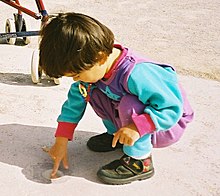
Back تطور الطفل Arabic Детска психология Bulgarian گەشەکردنی منداڵ CKB Infandisvolviĝo Esperanto Desarrollo infantil Spanish رشد کودک Persian Desenvolvemento infantil Galician התפתחות הילד HE बाल विकास Hindi Մանկան հոգեբանություն Armenian

Child development involves the biological, psychological and emotional changes that occur in human beings between birth and the conclusion of adolescence. It is—particularly from birth to five years— a foundation for a prosperous and sustainable society.[1]
Childhood is divided into three stages of life which include early childhood, middle childhood, and late childhood (preadolescence).[2] Early childhood typically ranges from infancy to the age of 6 years old. During this period, development is significant, as many of life's milestones happen during this time period such as first words, learning to crawl, and learning to walk. Middle childhood/preadolescence or ages 6–12 universally mark a distinctive period between major developmental transition points.[2] Adolescence is the stage of life that typically starts around the major onset of puberty, with markers such as menarche and spermarche, typically occurring at 12–14 years of age.[3] It has been defined as ages 10 to 24 years old by the World Happiness Report WHR.[1] In the course of development, the individual human progresses from dependency to increasing autonomy. It is a continuous process with a predictable sequence, yet has a unique course for every child. It does not always progress at the same rate and each stage is affected by the preceding developmental experiences. As genetic factors and events during prenatal life may strongly influence developmental changes, genetics and prenatal development usually form a part of the study of child development. Related terms include developmental psychology, referring to development from birth to death, and pediatrics, the branch of medicine relating to the care of children.
Developmental change may occur as a result of genetically controlled processes, known as maturation,[4] or environmental factors and learning, but most commonly involves an interaction between the two. Development may also occur as a result of human nature and of human ability to learn from the environment.
There are various definitions of the periods in a child's development, since each period is a continuum with individual differences regarding starting and ending. Some age-related development periods with defined intervals include: newborn (ages 0 – 2 months); infant (ages 3 – 11 months); toddler (ages 1 – 2 years); preschooler (ages 3 – 4 years); school-aged child (ages 5 – 12 years); teens (ages 13 – 19 years); adolescence (ages 10 - 25 years); college age (ages 18 - 25 years).
Parents play a large role in a child's activities, socialization, and development; having multiple parents can add stability to a child's life and therefore encourage healthy development.[5] Another influential factor in children's development is the quality of their care. Child-care programs may be beneficial for childhood development such as learning capabilities and social skills.[6]
The optimal development of children is considered vital to society and it is important to understand the social, cognitive, emotional, and educational development of children. Increased research and interest in this field has resulted in new theories and strategies, especially with regard to practices that promote development within the school systems. Some theories seek to describe a sequence of states that compose child development.
- ^ a b Center on the Developing Child (2007). The Science of Early Childhood Development (InBrief). Retrieved from www.developingchild.harvard.edu.
- ^ a b Collins WA, ed. (1984). "Introduction". Development During Middle Childhood: The Years From Six to Twelve. National Academies Press (US).
- ^ "Child Development: Young Teens (12-14 years old)". U.S. Centers for Disease Control and Prevention (CDC). 23 September 2021.
- ^ Toga AW, Thompson PM, Sowell ER (March 2006). "Mapping brain maturation". Trends in Neurosciences. 29 (3): 148–159. doi:10.1016/j.tins.2006.01.007. PMC 3113697. PMID 16472876.
- ^ "Parents Can Play Vital Role in Encouraging Children's Active, Healthy Lifestyles" (PDF). U.S. Centers for Disease Control and Prevention. Archived from the original (PDF) on 20 June 2017.
- ^ Brundavani V, Murthy SR, Kurpad AV (May 2006). "Estimation of deep-abdominal-adipose-tissue (DAAT) accumulation from simple anthropometric measurements in Indian men and women". European Journal of Clinical Nutrition. 60 (5): 658–666. doi:10.2307/1602366. JSTOR 1602366. PMID 16391572.